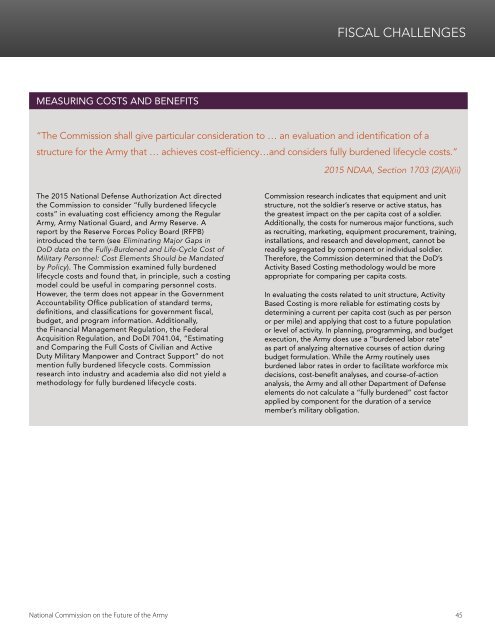THE FUTURE OF THE ARMY
Futurearmy
Futurearmy
Create successful ePaper yourself
Turn your PDF publications into a flip-book with our unique Google optimized e-Paper software.
FISCAL CHALLENGES<br />
MEASURING COSTS AND BENEFITS<br />
“The Commission shall give particular consideration to … an evaluation and identification of a<br />
structure for the Army that … achieves cost-efficiency…and considers fully burdened lifecycle costs.”<br />
2015 NDAA, Section 1703 (2)(A)(ii)<br />
The 2015 National Defense Authorization Act directed<br />
the Commission to consider “fully burdened lifecycle<br />
costs” in evaluating cost efficiency among the Regular<br />
Army, Army National Guard, and Army Reserve. A<br />
report by the Reserve Forces Policy Board (RFPB)<br />
introduced the term (see Eliminating Major Gaps in<br />
DoD data on the Fully-Burdened and Life-Cycle Cost of<br />
Military Personnel: Cost Elements Should be Mandated<br />
by Policy). The Commission examined fully burdened<br />
lifecycle costs and found that, in principle, such a costing<br />
model could be useful in comparing personnel costs.<br />
However, the term does not appear in the Government<br />
Accountability Office publication of standard terms,<br />
definitions, and classifications for government fiscal,<br />
budget, and program information. Additionally,<br />
the Financial Management Regulation, the Federal<br />
Acquisition Regulation, and DoDI 7041.04, “Estimating<br />
and Comparing the Full Costs of Civilian and Active<br />
Duty Military Manpower and Contract Support” do not<br />
mention fully burdened lifecycle costs. Commission<br />
research into industry and academia also did not yield a<br />
methodology for fully burdened lifecycle costs.<br />
Commission research indicates that equipment and unit<br />
structure, not the soldier’s reserve or active status, has<br />
the greatest impact on the per capita cost of a soldier.<br />
Additionally, the costs for numerous major functions, such<br />
as recruiting, marketing, equipment procurement, training,<br />
installations, and research and development, cannot be<br />
readily segregated by component or individual soldier.<br />
Therefore, the Commission determined that the DoD’s<br />
Activity Based Costing methodology would be more<br />
appropriate for comparing per capita costs.<br />
In evaluating the costs related to unit structure, Activity<br />
Based Costing is more reliable for estimating costs by<br />
determining a current per capita cost (such as per person<br />
or per mile) and applying that cost to a future population<br />
or level of activity. In planning, programming, and budget<br />
execution, the Army does use a “burdened labor rate”<br />
as part of analyzing alternative courses of action during<br />
budget formulation. While the Army routinely uses<br />
burdened labor rates in order to facilitate workforce mix<br />
decisions, cost-benefit analyses, and course-of-action<br />
analysis, the Army and all other Department of Defense<br />
elements do not calculate a “fully burdened” cost factor<br />
applied by component for the duration of a service<br />
member’s military obligation.<br />
National Commission on the Future of the Army 45


